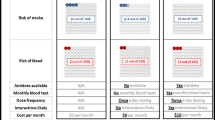Abstract
The maximum livelihood estimator (MLE) using a ranked set sample (RSS) usually has no closed expression because the maximum likelihood equation involves both hazard and inverse hazard functions, and may no longer be efficient when the judgment ranking is imperfect. In this paper, we consider a modified MLE (MMLE) using RSS for general parameters, which has the same expression as the MLE using a simple random sample (SRS), except that the SRS in the MLE is replaced by the RSS. The results show that, for the location parameter, the MMLE is always more efficient than the MLE using SRS, and for the scale parameter, the MMLE is at least as efficient as the MLE using SRS, when the same sample size is used. Under the perfect judgment ranking, numerical examples also show that the MMLE has good efficiency relative to the MLE based on RSS. When the judgment error is present, we conduct simulations to show that the MMLE is more robust than the MLE using RSS.
Similar content being viewed by others
References
Al-Saleh, M. F. and Al-Kadiri, M. (2000). Double ranked set sampling, Statist. Probab. Lett., 48, 205–212.
Al-Saleh, M. F. and Zheng, G. (2002). Estimation of bivariate characteristics using ranked set sampling, Australian & New Zealand Journal of Statistics, 44, 221–232.
Bai, Z. and Chen, Z. (2000). On the theory of ranked-set sampling and its ramifications, J. Statist. Plann. Inference (to appear).
Barnett, V. (1999). Ranked set sample design for environmental investigations, Environmental and Ecological Statistics, 6, 59–74.
Bhattacharyya, G. K. (1985). The asymptotics of maximum likelihood and related estimators based on type II censored data, J. Amer. Statist. Assoc., 80, 398–404.
Bohn, L. L. and Wolfe, D. A. (1994). The effect of imperfect judgment rankings on properties of procedures based on the ranked set samples analog of the Mann-Whitey-Wilcoxon statistic, J. Amer. Statist. Assoc., 89, 168–176.
Chen, Z. (2000). The efficiency of ranked-set sampling relative to simple random sampling under multi-parameter families, Statistica Sinica, 10, 247–263.
David, H. A. and Levine, D. N. (1972). Ranked set sampling in the presence of Judgment error, Biometrics, 28, 553–555.
Dell, T. R. and Clutter, J. L. (1972). Ranked-set sampling theory with order statistics background, Biometrics, 28, 545–555.
El-Neweihi, E. and Sinha, B. K. (2000). Reliability estimation based on ranked set sampling, Comm. Statist. Theory Method, 29, 1583–1595.
Godambe, V. P. (1960). An optimum property of regular maximum likelihood estimation, Ann. Math. Statist., 31, 1208–1212.
Godambe, V. P. (1991). Estimating Functions (ed. V. P. Godambe), Clarendon Press, Oxford.
Hettmansperger, T. P. (1995). The ranked-set sampling sign test, J. Nonparametr. Statist., 4, 263–270.
Kvam, P. H. and Samaniego, F. J. (1993). On maximum likelihood estimation based on ranked set sampling, with applications to reliability, Advances in Reliability (ed. A. Basu), 215–229, North Holland, Amsterdam.
Kvam, P. H. and Samaniego, F. J. (1994). Nonparametric maximum likelihood estimation based on ranked set samples, J. Amer. Statist. Assoc., 89, 526–537.
Lehmann, E. L. (1983). Theory of Point Estimation, Wiley, New York.
McIntyre, G. A. (1952). A method for unbiased selective sampling using ranked sets, Australian Journal of Agricultural Research, 3, 385–390.
Mehrotra, K. G. and Nanda, P. (1974). Unbiased estimation of parameters by order statistics in the case of censored samples, Biometrika, 61, 601–606.
Patil, G. P., Sinha, A. K. and Taillie, C. (1999). Ranked set sampling: A bibliography, Environmental and Ecological Statistics, 6, 91–98.
Sinha, B. K., Sinha, R. K. and Purkayastha, S. (1996). On some aspects of ranked set sampling for estimation of normal and exponential parameters, Statist. Decisions, 14, 223–240.
Stokes, S. L. (1980). Estimation of variance using judgment ordered ranked set samples, Biometrics, 26, 35–42.
Stokes, S. L. (1995). Parametric ranked set sampling, Ann. Inst. Statist. Math., 47, 465–482.
Stokes, S. L. and Sager, T. W. (1988). Characterizations of a ranked-set sample with application to estimating distribution functions, J. Amer. Statist. Assoc., 83, 374–381.
Takahasi, K. and Wakimoto, K. (1968). On unbiased estimates of the population mean based on the sample stratified by means of ordering, Ann. Inst. Statist. Math., 20, 1–31.
Yu, P. L. H. and Lam, K. (1997). Regression estimator in ranked set sampling, Biometrics, 53, 1070–1080.
Zheng, G. (2000). Some remarks on Fisher information in a ranked set sample (submitted).
Author information
Authors and Affiliations
About this article
Cite this article
Zheng, G., Al-Saleh, M.F. Modified Maximum Likelihood Estimators Based on Ranked Set Samples. Annals of the Institute of Statistical Mathematics 54, 641–658 (2002). https://doi.org/10.1023/A:1022475413950
Issue Date:
DOI: https://doi.org/10.1023/A:1022475413950




